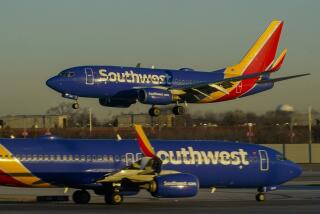Southwest grounds 79 Boeing planes for emergency inspections
Southwest Airlines grounded 79 of its Boeing 737 aircraft Saturday after a harrowing incident in which a hole tore in the fuselage of a plane bound for Sacramento and depressurized the cabin.
Southwest spokeswoman Brandy King said the company canceled 300 flights across the country so Boeing engineers could help conduct emergency inspections on the aircraft. Investigators from the National Transportation Safety Board and the Federal Aviation Administration were still trying to determine what caused the fuselage to rupture on Flight 812 from Phoenix to Sacramento on Friday afternoon. The aircraft, which contained 118 passengers, safely made an emergency landing in Yuma, Ariz.
Passengers described a terrifying and chaotic scene. Some reported hearing a noise like a small explosion or gunshot before the cabin lost pressure. While the aircraft’s breathing masks were deployed, some occupants lost consciousness. One flight attendant and one passenger were treated for minor injuries, according to the airline.
Photos: Hole opens up during Southwest flight
Saturday’s cancellations were felt throughout the airline’s network, and it was unclear when the grounded planes would be returned to service. At least 13 flights scheduled to depart from Los Angeles International Airport were canceled Saturday afternoon, including flights bound for San Francisco, Phoenix, Denver, Tucson, Albuquerque and Las Vegas.
Rita Aguilar-Cayo, 58, was among the scores of Southwest passengers at LAX awaiting word on their flights’ statuses Saturday. “I just arrived on a national flight from Tahiti and now I’m going home, and I really, really want to get there,” Cayo said. “But I’m starting to feel pretty insecure.”
Standing behind Cayo were 19 missionaries of various ages from Victory Christian Academy in Valparaiso, Ind. The group, dressed in identical orange T-shirts, was returning home from a year in Los Angeles. Group member Deanna Abner, 48, said they were unaware of Friday’s incident until they got in line to check their luggage Saturday. Asked whether she was worried, Abner shrugged. “God is in control. We don’t worry about it,” she said. “The worst that can happen is that we all go to heaven.”
Officials said the inspections could last for several days and that they were looking for any indications that other planes had “aircraft skin fatigue.”
Southwest has had problems with fuselages tearing in the past. In 2009, a foot-long hole opened in the top of a jet while it was cruising at 30,000 feet, forcing an emergency landing in West Virginia.
That same year, the airline was fined $7.5 million by the FAA for nearly 60,000 flights in which the planes had not undergone required inspections for fuselage cracks. “Given Southwest’s history, this raises a real concern,” said Jim Hall, a transportation consultant. “Everyone knows they pound those airplanes hard.”
The structural integrity of aging airline fleets has been an issue since 1988, when cracks caused the top of an Aloha Airlines Boeing 737’s fuselage to peel away while on its way to Honolulu. A flight attendant was sucked out of the depressurized craft, and dozens of passengers were injured.
That led to stricter inspection regulations, but through the years a number of airlines have had incidents where weakened fuselages tore apart in midair.
This year, the FAA implemented new rules requiring additional structural inspections of Boeing 757 and 737 aircraft. The agency rejected Southwest’s request for more time to complete inspections, which the company said would necessitate “out-of-sequence maintenance” that would cause “a significant burden.” Southwest’s fleet of 548 aircraft is made up of Boeing 737s; the one that tore open Friday is 15 years old, according to FAA records.
Hall said commercial aircraft used more for short-haul flights, which are common in Southwest’s flight schedule, are more prone to structural stress than long-haul aircraft. “They get pressurized and depressurized on a more frequent basis,” he said.
According to the airline’s website, the Southwest fleet has an average age of just over 11 years. On average, each plane flies six flights a day; the average trip is 648 miles and nearly two hours long.
Times staff writer Ruben Vives contributed to this report.
More to Read
Sign up for Essential California
The most important California stories and recommendations in your inbox every morning.
You may occasionally receive promotional content from the Los Angeles Times.










